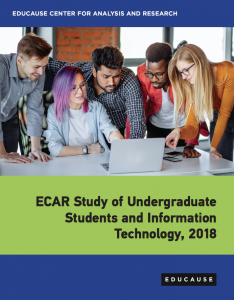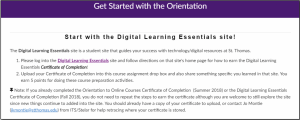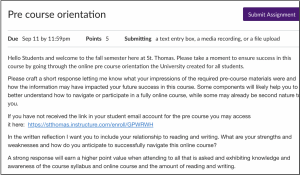In this article I introduce Strategy 1: Articulate the Goals, and Identify Ways to Assess the Goals. This is second in a series of blogs tailored to faculty and staff who create electronic learning resources for students. Our university uses the Canvas LMS for our for-credit courses as well as for orientation and student success sites.
The strategies in this blog series apply to resources created in both Canvas as well as resources using other electronic platforms. See the February Success Site blog for a list of all eight strategies.

Strategy 1: Articulate the Goals, and Identify Ways to Assess the Goals.
As you plan your student orientation and success sites, be explicit about the purpose(s) the site is designed for. As you clarify what you want students to get out of the resource, think about practical ways to assess the effectiveness of the site.
In other words: What are you aiming for, and how do you know when you hit the mark (or at least inch closer to it)?
To assist you in this planning stage, view this five minute Backwards Design Process video. This video is offered as inspiration and to give you ideas to adapt to your situation—not as a rigid prescription.
Our St. Thomas E-Learning and Research (STELAR) team incorporates elements of the Backwards by Design (Wiggins & McTighe, 2005) process into our course design with faculty. I think that this Backwards by Design approach is also helpful in the development of student success sites (including orientations and community sites).
Example of Strategy 1
During the fall 2018, a St. Thomas team launched a new student success module in Canvas called Degree Planning Essentials. Our purpose was to help students to understand their responsibilities for their own degree planning, to learn more about degree graduation requirements for their degree, and to know about the electronic degree planning tool “Degree Works.”
At the end of the module, students take a six question quiz that checks their understanding of concepts presented in the site. Students need to earn a certain score on the quiz in order to be able to register for their next semester. They can go back and further explore the site material and then retake the quiz at any time. We included a survey at the end of the semester to invite additional student feedback on their experience with this tool.
Kudos to Susan Anderson (Director of Academic Counseling), Christian Sobek (Administrative Assistant), and Dr. Wendy Wyatt (Associate Vice Provost of Undergraduate Studies) for identifying a clear purpose and goals for this Student Success Site. The team also identified a way to assess how the resource worked for the students during this first round to further inform the use of that resource during the second year of implementation.
Continually Revisit Your Goals (Strategy 1) to Reap Benefits!
These initial extra efforts in the design process (clarifying the purpose and goals for your site and how to assess how you reach your goals) will really pay off.
Don’t be surprised if you need to clarify your site purpose and goals as you begin developing the site. Eventually being able to articulate the goals, followed by ways to assess your goal(s), is an important step.
If the purpose (and what you want students to learn) is fuzzy for you as a developer of the site, chances are that it will also be fuzzy to the students. Conversely, if you clarify the site purpose and goals, this clarity will facilitate your ability to communicate the purpose and goals of the site to your students and thereby aide their success!
Strategy 1: Foundational to the Other Strategies
Recall the February Success Site blog and the eight strategies to plan orientation and success sites.
Clarity on your goals and ways to assess this (Strategy 1), in turn, helps inform the design of the site (Strategies 2-5). And clarity on the goals will also help you to better communicate the benefits of the site to others (Strategies 6 and 7). Finally, as you launch your site and reflect back on the “first run” of your site, reflecting upon what you are learning (Strategy 8) will be much easier by having initial designer goals and ideas on assessing them.
The next blog will illustrate Strategy 2: Create a clear home page and simple site navigation so students start and stay with it.
Citations:
Galanek, J.D., Gierdowski, D.C, & Brooks, D.C. ECAR Study of Undergraduate Students and Information Technology, 2018. Research report. Louisville, CO: ECAR, October 2018.
Wiggins, G., & McTighe, J. (2005). Understanding by design (2nd edition). Alexandria, VA: Association for Supervision and Curriculum Development.
This post was written by Jo Montie, Online Learning Systems Facilitator with the St. Thomas E-Learning and Research (STELAR) Center at the University of St. Thomas in St. Paul, Minn. To learn more about this topic, please visit our website at www.stthomas.edu/stelar or email Jo at jkmontie@stthomas.edu.
 Another way to use data to inspire your work: Read the Educause ECAR
Another way to use data to inspire your work: Read the Educause ECAR 





